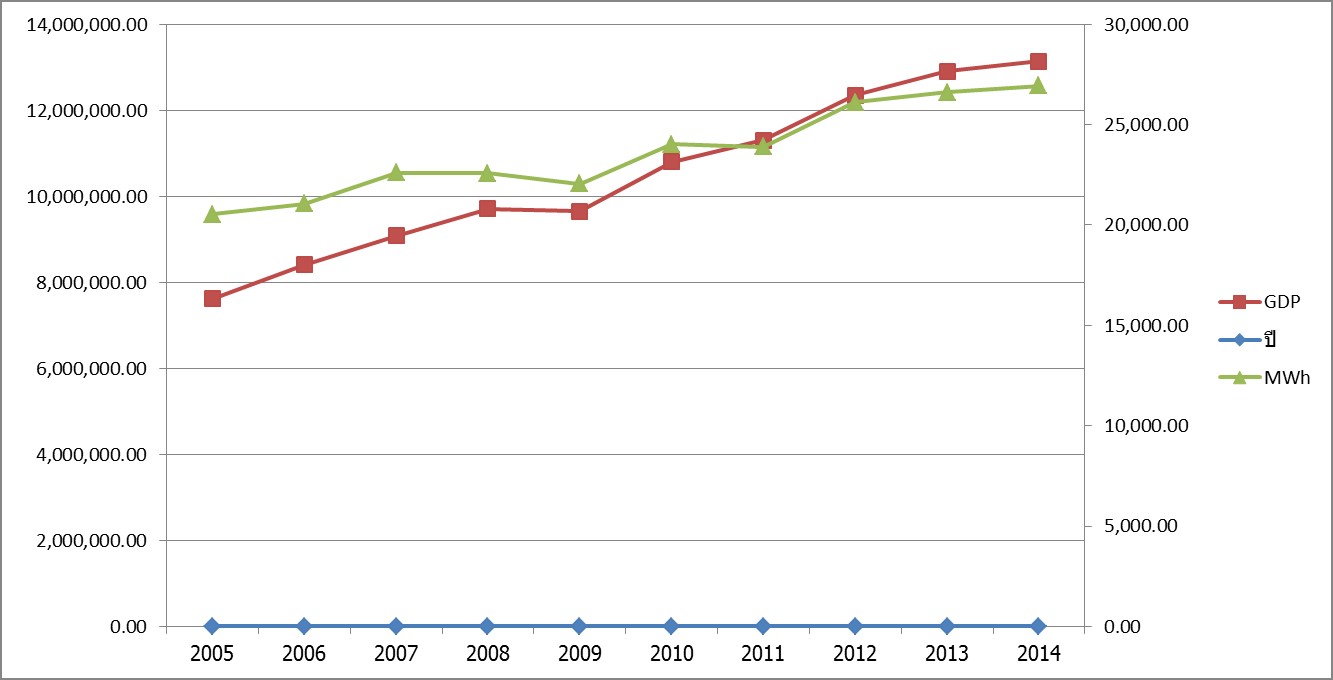การประเมินความคุ้มค่าทางการเงินของการติดตั้งระบบผลิตไฟฟ้าจากเซลล์แสงอาทิตย์ กรณีศึกษา โรงงานผลิตไม้ยางพาราแปรรูปในจังหวัดตรัง
คำสำคัญ:
ความคุ้มค่าทางการเงิน, มูลค่าปัจจุบันสุทธิ, อัตราส่วนผลประโยชน์ต่อต้นทุน, อัตราผลตอบแทนภายใน, ระยะเวลาคืนทุนแบบคิดลด, ระบบผลิตไฟฟ้าจากเซลล์แสงอาทิตย์, โรงงานผลิตไม้ยางพาราแปรรูปบทคัดย่อ
งานวิจัยชิ้นนี้มีวัตถุประสงค์เพื่อวิเคราะห์หาความคุ้มค่าทางการเงินของการติดตั้งระบบผลิตไฟฟ้าจากเซลล์แสงอาทิตย์บนหลังอาคาร ของโรงงานผลิตไม้ยางพาราแปรรูปในจังหวัดตรัง โดยพิจารณาจากมูลค่าปัจจุบันสุทธิ (Net Present Value: NPV) อัตราส่วนผลประโยชน์ต่อต้นทุน (Benefit and Cost ratio) อัตราผลตอบแทนจากการลงทุน (Internal Rate of Return: IRR) และ ระยะเวลาคืนทุน (Payback Period ) ทั้งจากกรณี 1) ผลทางตรง 2) ผลทางตรงบวกผลทางอ้อมด้านภาษี และ 3) ผลทางตรงบวกผลทางอ้อมด้านค่าความต้องการไฟฟ้าสูงสุด ผลการศึกษาที่ได้พบว่าโรงงานขนาดใหญ่ มีความได้เปรียบด้านต้นทุนระบบต่อขนาดกำลังผลิตติดตั้ง และด้านต้นทุนการผลิตไฟฟ้าต่อหน่วย เนื่องจากการประหยัดต่อขนาด (Economies of Scale) นั่นคือ ขนาดกำลังผลิตยิ่งสูง ต้นทุนต่อหน่วยยิ่งต่ำ คือ มีต้นทุนเท่ากับ 2.32, 2.69 และ 3.08 บาทสำหรับขนาดกำลังการผลิตที่ มากกว่า 100kW, 51-100kW, 11-50kW ตามลำดับซึ่งต่ำกว่าค่าไฟฟ้าในช่วง Peak ซึ่งอยู่ที่ 4.21 บาทต่อหน่วย นอกจากนี้ยังพบว่าการติดตั้งระบบผลิตไฟฟ้าจากเซลล์แสงอาทิตย์ จะมีระยะคืนทุนเร็วสุดที่ 5.59 ปีที่ขนาดกำลังที่มากกว่า 100kW อีกทั้งเมื่อวิเคราะห์ความคุ้มค่าทางการเงิน โดยใช้มูลค่าปัจจุบันสุทธิ อัตราส่วนผลประโยชน์ต่อต้นทุน อัตราผลตอบแทนภายในของโครงการ รวมไปถึงระยะคืนทุนแบบคิดลดกระแสเงินสด รวมถึงการวิเคราะห์ความอ่อนไหวในกรณีต่างๆ ไม่ว่าจะเป็นเมื่อดอกเบี้ยเงินกู้ที่ใช้คิดลดมีอัตราเพิ่มขึ้น, เครื่อง Inverter มีอายุการใช้งานลดลง, แผงโซลาเซลล์ที่ใช้มีค่าความเสื่อมเพิ่มขึ้น และกรณีที่ฤดูการณ์ทำให้การผลิตกระแสไฟฟ้าได้ลดลง ผลการศึกษาที่ได้ต่างสอดคล้องไปในทิศทางเดียวกัน นั่นคือ โครงการติดตั้งระบบผลิตไฟฟ้าจากเซลล์แสงอาทิตย์ สำหรับโรงงานผลิตไม้ยางพาราแปรรูปในจังหวัดตรัง มีความคุ้มค่าในการลงทุน ซึ่งนับเป็นสัญญาณที่ดีที่ภาครัฐจะสามารถนำผลการศึกษาที่ได้ใช้ในการรณรงค์ให้โรงงานอุตสาหกรรมหันมาใช้พลังงานทางเลือกอย่างเช่นการติดตั้งระบบผลิตไฟฟ้าจากเซลล์แสงอาทิตย์เพิ่มมากขึ้นในอนาคต
References
Anan Suwanchaisakul. (2008). Financial and economic feasibility of producing electricity from solar cells for households and villages. Specialized research, Master of Economics Program, Faculty of Economics Thammasat University
Chularat Jumpirat. (2015). Financial feasibility study of solar power generation projects installed on Solar PV Rooftop for residential household in Mae Sariang district Mae Hong Son Province. Master Independent study. Kasetsart University
Department of Alternative Energy Development and Energy Conservation. Alternative Energy Development Plan and Alternative Energy 2015-2036. Alternative Energy Development Plan (AEDP2015). Ministry of Energy Policy and Planning Office Energy. Retrieved from http://www.eppo.go.th/images/POLICY/PDF/PDP_TH.pdf (Searched on 20 February 2018).
Department of Alternative Energy Development and Efficiency. Ministry of Energy. (2015). Energy Consumption Statistics. searched on 23 February 2018. Retrieved from http://www.dede.go.th/ewt_news.php?nid=42079
Natthapong Suwanasang and Sopitsuda Tongsopit. (2015). An Assessment of the Technical and Economic Potential of Rooftop Solar Systems on Chulalongkorn University’s Buildings. Journal of Energy Research. Year 12, Issue 2 (July-December) 2015.
Prasart Meetam. (2015). The right to use sunlight to produce electricity must be protected and make it true. (Regret sunny). Committee Independent organization for consumer protection
Prinyaporn Boonsirisuk (2014). Using renewable energy by using solar energy of households in Chiang Mai Case study of Chiang Mai Municipality. Independent study Master of Economics Program, Chiang Mai University
Rachan Chuchat. (2015). Analysis of demand for electric power In order to evaluate the cost and return of the Solar installation rooftop on the roof of the case study Prince of Songkla University Hat Yai Campus. Research Methods in Economics, Faculty of Economics Prince of Songkla University Hat Yai Campus
Samart Wongrit. (2012). Area suitability for solar cell installation in Thailand using Geographic information database together with the solar radiation intensity map. Master of Engineering Thesis, Kasetsart University
Thanapol Tantisatayakul et.al. (2017). An assessment of energy, environmental and economic benefits for systems Solar power generation on the roof of the building within Thammasat University, Rangsit Campus. Science Journal And Technology Year 25, Issue 6, November - December 2017
Thanapol Tantisatayakun (2015). Assessment of financial support measures for power generation systems Residential solar roof in Thailand Journal of Science and Technology, Year 23, Issue 4, May-June 2015, Thammasat University
Thanai Phothisat et.al. (2017). A guide to the development of solar power generation projects installed on the roof for Thailand. Department of Alternative Energy Development and Efficiency, Ministry of Energy.
Wiwat Chanovit. (2014). Cost and return analysis of solar power generation projects installed on Residential type roof In different areas of Thailand. Business Economics Course Thesis, Institute Graduate School of Development Administration

Downloads
เผยแพร่แล้ว
How to Cite
ฉบับ
บท
License
Copyright (c) 2020 https://creativecommons.org/licenses/by-nc-nd/4.0/

This work is licensed under a Creative Commons Attribution-NonCommercial-NoDerivatives 4.0 International License.


